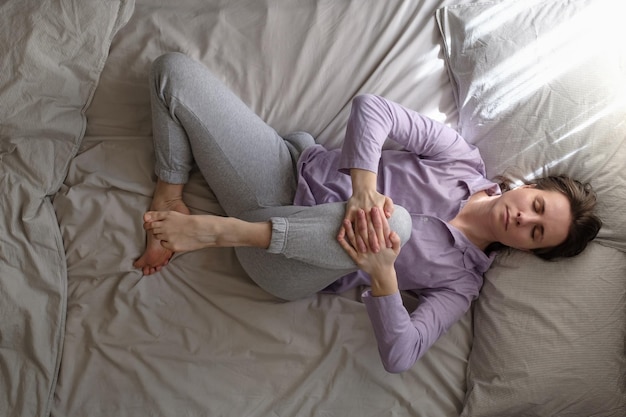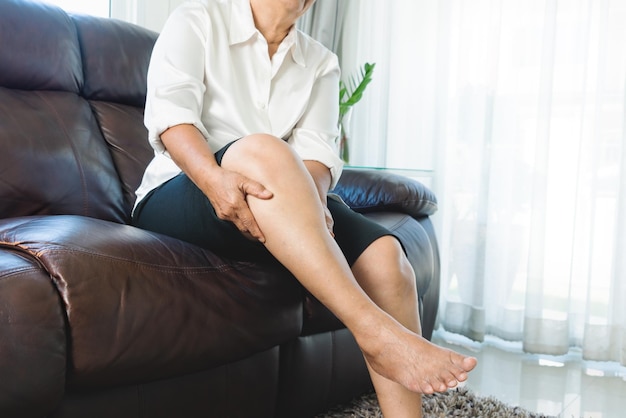Restless Legs Syndrome (RLS) is a pervasive condition that can significantly impact your quality of life, particularly affecting your sleep. This article delves into what RLS entails, its sensations, and offers practical tips and remedies for managing the symptoms and improving your sleep. Understanding this condition is crucial for those who live with it, as effective management can lead to more restful nights and a better overall quality of life.
What is Restless Legs Syndrome?
Restless Legs Syndrome, also known as Willis-Ekbom Disease, is a neurological disorder characterized by an uncontrollable urge to move your legs. This urge is usually accompanied by uncomfortable sensations that can range from mild to unbearable. These sensations typically occur in the evening or nighttime hours when you’re trying to rest or sleep, making it particularly disruptive to achieving a good night’s rest.
The neurological origins of RLS mean that it’s not just a simple case of fidgety legs; it involves complex interactions in the brain that trigger these uncomfortable sensations. Understanding that RLS is a neurological condition can help in approaching treatment and management with the seriousness it deserves. Moreover, acknowledging that it often goes underdiagnosed can empower sufferers to seek medical advice and explore a range of interventions.
What Does Restless Legs Syndrome Feel Like?
For those who experience it, RLS often feels like tingling, burning, or a creeping sensation in the legs. Some describe it as having insects crawling under the skin or a constant itch that can’t be scratched. The sensations are often relieved temporarily by movement, such as walking or stretching, but return when resting. These descriptions highlight the persistent and intrusive nature of RLS, which can make it difficult to relax, especially when trying to sleep.
The sensations associated with RLS can vary in intensity and frequency, sometimes coming and going in waves. This unpredictability can make it challenging to manage and frustrating for sufferers who might find it difficult to explain their experiences to others. The intermittent relief provided by movement can lead to a cycle of restlessness that exacerbates sleep issues, further impacting overall health and well-being.
Symptoms of Restless Legs Syndrome
The primary symptom of restless legs syndrome is the urge to move the legs, but there are other symptoms to be aware of:
- Uncomfortable sensations in the legs
- Symptoms that worsen during periods of rest or inactivity
- Relief with movement
- Symptoms that worsen in the evening or at night
- Sleep disturbances due to leg discomfort
If you experience these symptoms regularly, it’s important to consult a healthcare professional to determine if you have RLS. Early diagnosis can lead to more effective management strategies, improving both sleep quality and daily functioning. It’s important to note that while RLS primarily affects the legs, in some cases, similar sensations can occur in the arms or other parts of the body, which can further complicate the condition.
Expert Diagnosis for Restless Legs Syndrome
At El Paso Sleep Center, we specialize in identifying and treating sleep disorders like Restless Legs Syndrome (RLS), which often goes undiagnosed or misunderstood. If you’re experiencing an uncontrollable urge to move your legs at night or discomfort that keeps you awake, our team is here to help. We provide comprehensive evaluations that include reviewing your medical history, symptoms, and lifestyle to determine whether RLS or another sleep condition is affecting your rest. Early diagnosis is key to improving your sleep and overall well-being.
Living with Restless Legs Syndrome
Living with restless legs syndrome can be challenging, but there are several strategies you can adopt to manage your symptoms and improve your sleep quality. By integrating lifestyle changes and practical tips into your daily routine, you can alleviate some of the discomfort associated with RLS. These strategies can not only improve sleep but also enhance overall well-being by reducing stress and promoting relaxation.

Restless Legs Remedies and Tips for Better Sleep
- Establish a Sleep Routine: Going to bed and waking up at the same time every day helps regulate your body’s internal clock and can improve sleep quality. A consistent sleep schedule is especially important if you have RLS, as it can help minimize the unpredictability of symptoms. Over time, a regular sleep routine can also reduce anxiety associated with going to bed, which can itself be a trigger for RLS.
- Create a Relaxing Bedtime Environment: Make your bedroom a sleep-friendly zone. Keep it cool, dark, and quiet. Consider using blackout curtains, earplugs, or a white noise machine to minimize disruptions. A calming environment can promote relaxation and prepare your body for rest, which is crucial for those dealing with the nightly challenges of RLS.
- Exercise Regularly: Regular physical activity can help reduce RLS symptoms. Aim for moderate exercise, like walking or swimming, but avoid vigorous exercise close to bedtime as it might worsen symptoms. Finding a balanced exercise routine can enhance circulation and reduce the severity of symptoms, contributing to better sleep quality over time.
- Stretch Before Bed: Gentle stretching or yoga before bed can help relax your muscles and reduce RLS symptoms. Focus on stretches that target the legs. Incorporating stretching into your nightly routine can become a relaxing ritual that signals to your body that it’s time to wind down and prepare for sleep.
- Limit Caffeine and Alcohol: Both caffeine and alcohol can exacerbate RLS symptoms. Try to limit these substances, especially in the hours leading up to bedtime. Reducing or eliminating these stimulants can significantly improve sleep quality and reduce the frequency and severity of RLS symptoms.
- Stay Hydrated: Dehydration can worsen RLS symptoms. Ensure you are drinking enough water throughout the day. Staying hydrated is a simple but effective way to help manage RLS, as it can help maintain overall bodily functions and reduce discomfort.
- Warm Bath or Massage: Taking a warm bath or having a leg massage before bed can help relax your muscles and alleviate discomfort. These practices can be part of a calming bedtime routine that prepares both your body and mind for rest, offering immediate relief from the persistent sensations of RLS.
- Use Heat or Cold Therapy: Applying a warm compress or ice pack to your legs can provide temporary relief from RLS symptoms. Experimenting with heat and cold can help you determine which method offers the most comfort, providing a personalized approach to symptom management.
Understanding the Causes and Triggers
While the exact cause of restless legs syndrome is unknown, several factors are believed to contribute to its development. These include:
- Genetics: RLS can run in families, indicating a genetic component. Understanding the genetic link can provide insight into the condition and help in managing expectations for treatment outcomes.
- Iron Deficiency: Low levels of iron in the brain can trigger or worsen RLS symptoms. Addressing iron deficiency can be a straightforward way to reduce symptoms, particularly if identified early.
- Chronic Diseases: Conditions like diabetes, kidney failure, and Parkinson’s disease have been linked to RLS. Managing these underlying conditions can often alleviate the severity of RLS symptoms, providing dual benefits for overall health.
- Medications: Certain medications, including antinausea drugs, antipsychotics, and some antidepressants, can trigger RLS symptoms. Reviewing medications with a healthcare provider can help identify potential contributors to RLS and adjust treatments accordingly.
Identifying Your Triggers
It’s helpful to identify any personal triggers that may worsen your RLS symptoms. Keep a diary of your symptoms, noting what you ate, your activities, and any medications taken. This can help pinpoint any specific triggers and aid in developing a personalized management plan. Understanding your unique triggers empowers you to make informed decisions about lifestyle changes and treatment options, leading to more effective symptom management.
When to Seek Professional Help
If lifestyle changes and home remedies do not alleviate your symptoms, it’s important to seek professional help. A healthcare provider can help diagnose RLS and recommend appropriate treatment options. Early intervention can prevent symptoms from worsening and improve your quality of life significantly.

Restless Legs Treatments
Treatment for RLS focuses on alleviating symptoms and improving sleep quality. Options may include:
- Iron Supplements: If your RLS is linked to iron deficiency, iron supplements might be recommended. This straightforward treatment can lead to significant improvements in symptoms for some individuals.
- Medications: Several medications can help manage RLS symptoms, including dopaminergic agents, anticonvulsants, and opioids. It’s important to work closely with a healthcare provider to find the most effective medication with the fewest side effects.
- Addressing Underlying Health Conditions: Managing conditions such as diabetes or kidney disease can help reduce RLS symptoms. Comprehensive management of health conditions can lead to improvements in RLS, highlighting the importance of a holistic approach to treatment.
Personalized Sleep Studies and Treatment Plans
Restless Legs Syndrome can have a major impact on your ability to fall and stay asleep. At El Paso Sleep Center, we use advanced sleep studies to track your nighttime patterns and uncover the root cause of your symptoms. Based on your results, our sleep specialists create personalized treatment plans that may include iron therapy, medication, or lifestyle modifications. Our goal is to provide practical, science-backed solutions that reduce discomfort and restore your ability to sleep through the night.
Conclusion
Living with restless legs syndrome can be frustrating, but with the right strategies and treatments, you can manage your symptoms and improve your sleep. By understanding your triggers, maintaining a healthy lifestyle, and seeking professional guidance when necessary, you can find relief and enjoy a better quality of life. Remember, you’re not alone, and help is available to guide you on your journey to restful nights. Embracing a proactive approach to managing RLS can lead to significant improvements in both sleep and daily life, ensuring that you are equipped to handle the challenges of this condition effectively.
Ongoing Support for Long-Term Relief
Managing RLS takes more than a one-time consultation—it requires continued care and support. El Paso Sleep Center offers ongoing treatment monitoring and adjustments to ensure that your plan continues to work as your body and lifestyle change. Whether it’s refining medication, offering relaxation techniques, or addressing coexisting health conditions, we’re committed to helping you achieve long-term relief from restless legs and better, more restorative sleep. Don’t let RLS control your nights—let our team help you take back control.
If you’d like to dive deeper into understanding Restless Legs Syndrome and explore additional treatment resources, the Restless Legs Syndrome Foundation offers trusted information and support.
👉 Visit the RLS Foundation here to learn more.








